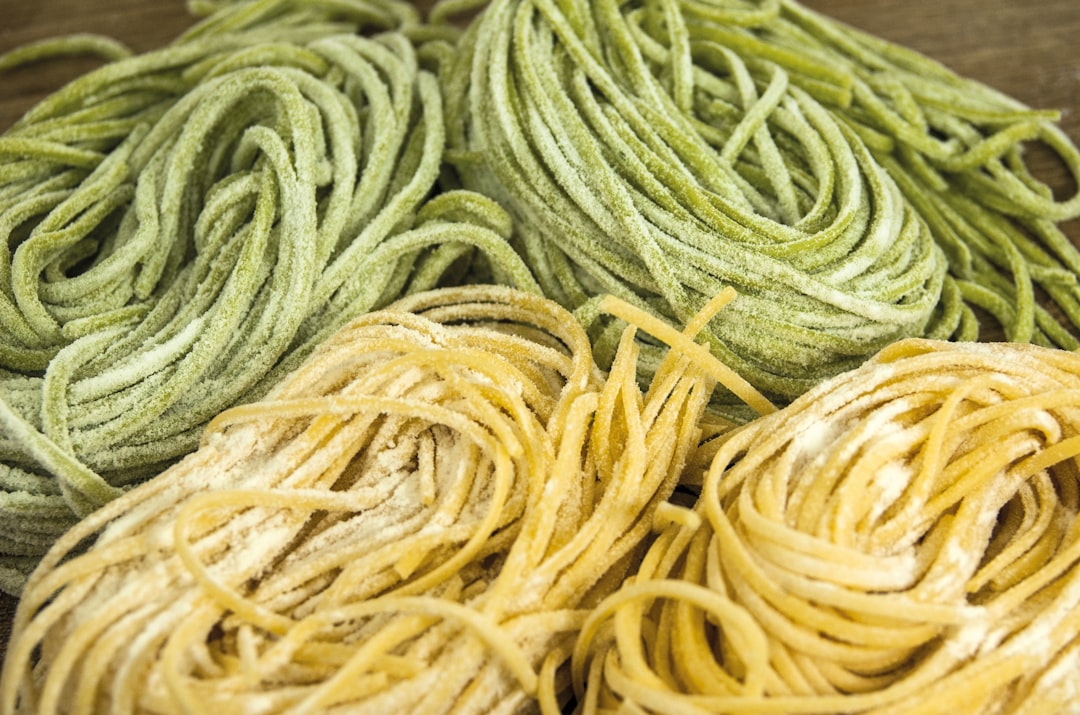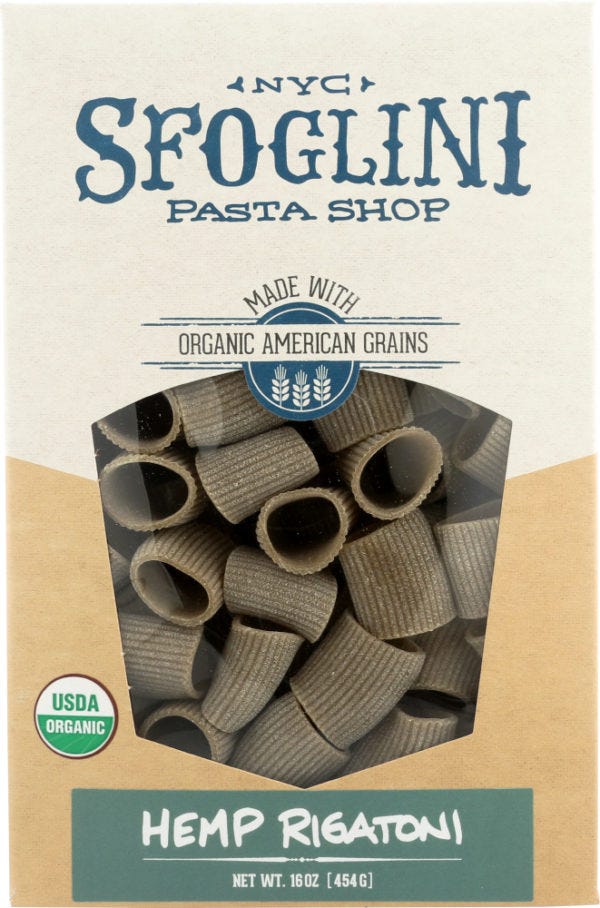Mmmmm...cannabis pasta
Trying out hemp rigatoni and a new The Plant Lady episode with Happy Munkey's Vlad Bautista

A note about programming: Without going into too much detail, I’ll likely have my sweet babe in my hands this time next week! I’ll be taking some weeks off to get acquainted with him, and then I’ll be back here sharing lots of things, including…dun dun dunnnnnnn…my post-pregnancy return to weed! And ten more new The Plant Lady episodes. I appreciate everyone renewing their subscriptions recently, in general, and especially because I’m on maternity leave and not on my job’s payroll at the moment. Nobody is obligated to contribute monetarily, and that’s why I keep all my newsletters free, but I appreciate those who do, so thank you. Either way, please don’t take my absence as anything else other than me having a life-changing medical event—I’ll be back soon!
Anybody who has spent more than five seconds around a cannabis activist or enthusiast knows this saying: “Anything you make with plastic, you can make with hemp.”
It’s pretty much true! I think a lot of us are sitting here waiting for the industrial hemp revolution, which has yet to take hold and would likely be a boon for our struggling environment. But this particular newsletter issue isn’t about that.
It’s about hemp as a food product rather than a building or container material. It’s a bit of a stretch to say that anything you can make with grains, you can also make with hemp, mostly owing to its strong taste and the fact it’s not actually a grain, but it’s definitely a more versatile food product than it gets gredit for. Take hemp granola, for example, which tastes nutty and is more or less indistinguishable from other types of granola. I particularly like it in açaí bowls, where it gives texture and a shot of protein to balance out all that sugar.
For all my love of the cannabis plant, I’ve otherwise kind of ignored hemp foods. Honestly, there’s no real reason other than the fact I just haven’t been curious enough, I guess. But a little while ago, I came across a box of hemp pasta from one of my favorite artisanal dried pasta makers, Sfoglini in New York, and realized I had to try it.
Sfoglini, in addition to making top-quality dried pasta in shapes both old and lesser-known, as well as new, like its line created by Dan Pashman of the popular food podcast The Sporkful, is also known for incorporating heritage grains and less common ingredients. Being the lifelong pasta slut that I am, I’ve tried literally every type the company has ever made: saffron malloreddus, Einkorn macaroni, rye trumpets, kale penne, whole grain radiators, and all of its “regular” durum semolina types, too.
I held onto my box of Sfoglini hemp rigatoni box for a while, truthfully being kind of turned off by the possibility of tasting weed in my pasta when I’m just trying to have dinner after a long day, not necessarily interested in experimenting. I have a feeling I’m not alone in that. The company’s hemp shapes are currently not for sale on its website anymore, though many smaller stockists (and large, including Amazon) still sell it all across the world wide web.
Why incorporate hemp into pasta at all? Isn’t pasta doing just fine without the cannabis plant? There are actually plenty of compelling reasons. First of all, in the case of Sfoglini’s pasta it’s made by milling hemp seeds and adding them to the durum semolina wheat pasta dough. Many people have dubbed hemp a “superfood,” a nebulous and annoying term that mostly means it’s packed with an incredible amount of nutrients and not too much that’d bad for us. In particular, hemp is a good source of protein, vitamin E, all 20 amino acids, Omegas 3-6, fiber, magnesium, iron, phosphorus, and zinc.
Hemp also just works well as an added ingredient to durum semolina flour. “We first entertained the idea of using hemp when organic hemp was authorized to be grown in New York State, around 2017,” says Scott Ketchum, co-founder and CEO of Sfoglini. “We were able to get a sample of hemp powder to do some R&D work with and were very pleasantly surprised by the taste, which of course is the most important thing when it comes to making pasta. The extra nutritional benefits that come along with hemp were just a bonus!”
About that taste: it’s nutty. That’s the adjective many people mentioned when I asked if they’d ever tried hemp pasta, and I completely agree. My husband said this particular type was “earthy, between the mushroom pasta they make and the whole wheat kind” (specifically, he’s referring to Sfoglini’s porcini and whole wheat varieties).
When I finally made it, I figured a heavier sauce would be better, so I paired it with a spicy red tomato passata and fresh ricotta cheese. It was a great pairing, but with admittedly strong ingredients, so I think anyone trying to enhance and bring out the flavor might go for something different, like a pesto, which is still strongly flavored but has complementary elements like nuts, olive oil, and garlic (it’s the favored combo of hemp pasta enthusiast and Twitter user Timothy Dexter). He likes hemp pasta because it’s a higher protein option.
Ketchum favors pairing with “squash—either an already prepared pasta sauce or roasted butternut squash–or you can just add some ricotta cheese with black pepper and hemp or olive oil. That's super simple and delicious,” he says.
Sfoglini’s website offers other recipes: one with shrimp, tomatoes, and corn; and one with pan-roasted fennel and cauliflower (pictured at the top of this piece).
The recurrence of ricotta makes sense to me, as it was my initial pairing, too: the earthy, nutty taste of the pasta goes really well with a creamy, fresh cheese. I’m also thinking ingredients like morels, nettles, peas, and garlic scapes, to give some examples, might make for a lively spring-inspired pasta dish.
Others who have tried it on Twitter had it with “a heavy cream sauce at an infused dinner,” says Debra Borchardt, co-founder and executive editor of Green Market Report. Twitter user @Ridesmith advocated for heavier sauces with meat and lots of cheese, which was the direction I ended up going. He also noted that it had “clumsy gluten,” which I could definitely imagine being the case with higher hemp-to-semolina ratios.
Sfoglini’s hemp pasta, in particular, uses less hemp and more semolina flour. I think they nailed the ratio on this one—the flavor tastes nothing of weed and is not too overpowering. Ketchum referred to hemp’s addition as an “additive or garnishment” and added that hemp is so strongly flavored one only needs to add a little bit to get a good dose of favor. He also clarified that hemp is “…not really a grain. We still needed the durum semolina wheat in order for the pasta to have the right protein and gluten levels in order to make pasta. We mill the seeds to look like a grain,” he says, adding that “people are cooking more and more with [hemp] every day.”
Health-wise, since Sfoglini’s hemp pasta version is mostly semolina flour, it doesn’t change much. There are other hemp pastas on the market that have a higher hemp-to-semolina ratio. In addition to having a much stronger taste, they’re also significantly more gummy, owing to the lack of gluten. They also pack a stronger health punch, including having a lower glycemic index.
Home cooks who have access to milled hemp seeds or the ability to do it themselves can easily try this at home. “You can blend the hemp powder with your flour if you're able to find a supplier,” Ketchum says. “It can be difficult to find the milled hemp seeds. You only need it to be about 10% of your mix, though. You could also drizzle some hemp oil on your pasta instead of olive oil if you want to get some extra flavor.”
Still, for all its promises, hemp pasta has yet to catch on in the mainstream, which I think has more to do with the specter of its name and associated smells and tastes than its reality, which is pleasant and delightfully un-weedy.
Ketchum isn’t sure if it’ll ever be widely adopted. “We really like the pasta, but it's a hard sell for some people. They just need to try it out! Some people are just pasta purists and do not like other ingredients incorporated into the pasta. Color also seems to be a big factor—some people don't want to eat a pasta because it's green,” he says. That might be the key right there: I have a feeling readers of Cannabitch might be the perfect crowd to spring for green pasta.
The Plant Lady, Episode 5: Vladimir Bautista of Happy Munkey
“One day when I was 16 years old, I told myself, ‘You know what? I’m going to buy an ounce and if it doesn’t sell, I’ll smoke it. I have nothing to lose and everything to gain,” Vladimir Bautista (pictured on the left) says in episode five of The Plant Lady via San Diego Magazine. “If it wasn’t for that, I don’t think I would be here with you, Jackie.”
I sat down with Vlad Bautista, CEO and co-founder of NYC cannabis lifestyle brand Happy Munkey. Our chat was long overdue—we had circled around one another for years and finally got the chance to connect. I think you’ll be able to hear the strong and good vibes over the airwaves—after all, we are both New Yorkers, and we were able to connect on that level, especially. We talked about what the fuck is going on with New York’s legalization (the market in which Happy Munkey hopes to become a dispensary one day soon), his activism in the Dominican Republic, having come up in a neighborhood ravaged by the War on Drugs, the importance of soft activism through cannabis events, and more.










This is so interesting!
I was never so stoned as the time I put fresh-dried cannabis leaves in the pasta water, when I was 20 years old. Eye-opening, really.